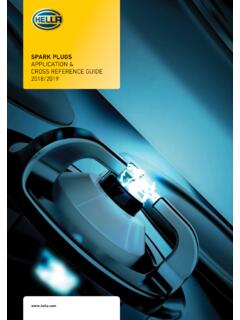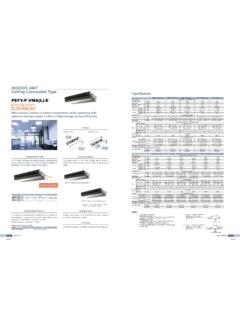Transcription of SKC Ltd Step by Step Guide to Air Sampling
1 By step GuideAn Introduction to Air SamplingAir Sampling BasicsPage 2 224-G1 Issue F is Air Sampling ? ..1 Types of Contaminant ..2mg/m and ppm ..3 How is Air Sampling Carried Out? ..4 Dust Conventions ..5 Sampling Sample Train ..7 Calibration ..8 The SKC Air Sampling Pump IOM Sampler ..10 Inhalable Dust Sampling using the IOM Sampler ..11 Respirable Dust Sampling using the Cyclone Sampler ..14 Gas & Vapour Sampling using Sorbent Tubes ..18 Gas & Vapour Sampling using Impingers ..21 Bag Sampling ..25 Basic Formulae ..27A helping hand from the expertsThis Guide is designed as an introduction to the basic principles of air Sampling methods and deals with the setting up of the equipment. Advice notes relating to specific Sampling strategies, methods, and protocols can be obtained from the HSE ( ) and these will give you a good understanding of the approach you should take to Sampling in your particular industry.
2 SKC equipment is suitable for many situations and applications beyond what is covered in this Guide , and more information can be found on our website and in the pump you are new to air Sampling , our one day training course A Practical Course in Air Monitoring will give you the help you need to get started. The course includes both theoretical and practical sessions in the use of air Sampling equipment. An experienced practitioner will offer valuable insights on air Sampling and will assist with instrument configuration and calibration. Contact SKC Limited customer services today for details on courses and available dates:Phone: +44 (0) 1258 480188 Email: 224-G1 Issue F Page 1 What is Air Sampling ?What is air Sampling ?Put simply, air Sampling is capturing the contaminant from a known volume of air, measuring the amount of contaminant captured, and expressing it as a concentration. This means that an air sample requires three basic measurements:1.
3 The flow rate of air through the collection medium2. The sample run time3. The amount of contaminant collectedThe volume of air is calculated by multiplying the flow rate through the collection medium by the sample run time. It is important to know the exact volume of air sampled, so accurate calibration of the flow rate should be carried out before and after each sample is x Time = Volume of air sampledThe concentration is calculated by dividing the amount of contaminant collected by the volume of air sampled, and it is expressed either as milligrams per cubic metre (mg/m ) or parts per million (ppm).Amount Volume = Concentration of contaminantWhy perform air Sampling ?Some substances present in workplaces can be harmful to health, so levels of exposure to these hazardous substances must be monitored to protect workers. In the European Union, maximum exposure levels for these hazardous substances are set out in the current Indicative Occupational Exposure Limits Directive (IOELD).
4 In the UK the guidance document for this is EH40/2005 Workplace Exposure Limits, and similar documents are produced in the other EU countries. EH40 specifies maximum exposure levels for substances that are deemed potentially harmful. These are referred to as Workplace Exposure Limits (WELs).WELs are concentrations of hazardous substances in the air, averaged over a specified period of time, referred to as a time weighted average (TWA). Two time periods are used: Long term (8 hours) and short term (15 minutes). Short term exposure limits (STELs) are set to help prevent effects such as eye irritation, which may occur following exposure of only a few minutes. EH40 also highlights other important information about the substance, such as whether it is a skin sensitizer, carcinogenic, or whether biological monitoring guidance also is important to note that substances that have been assigned a WEL are subject to the requirements of the UK Control of Substances Hazardous to Health (COSHH) Regulations, which require employers to prevent or control exposure to hazardous substances.
5 For more information please visit Page 2 224-G1 Issue F of ContaminantThere are three types of contaminant according to their physical properties: Particulates Vapours GasesParticulates can be further subdivided into five types: Aerosols Dusts Fumes Smokes Mists FibresContaminant DefinitionsAerosolDispersion in air of solid particles of microscopic particulate capable of temporary suspension in air. Dusts are usually derived from larger masses through the application of physical particles produced by condensation from the gaseous phase. Fumes are usually derived from the intense heating of a solid (commonly metals) beyond its melting point, for example when welding. The intense heat vaporises some of the solid, and the fume is formed by the subsequent cooling of the gas resulting from the incomplete combustion of organic matter consisting predominantly of carbon and oxides of in air of liquid droplets usually large enough to be seen by the naked of natural or synthetic materials that are significantly longer than they are wide.
6 Examples include asbestos and glass phase of a substance that usually exists as a liquid or solid at normal room temperature and substance which does not normally exist as a liquid or solid at normal room temperature and 224-G1 Issue F Page 3mg/m and ppm1 part per million (ppm)is approximately the same as the contents of a party balloon compared to the volume of air inside 50 three bedroom houses1 milligram per cubic metre (mg/m )is approximately the same as one teaspoon of dust spread in thevolume of air 1metre above the area of a football (soccer) fieldTeaspoon1 metre highX 1X 50 Concentrations are expressed as milligrams per cubic metre (mg/m ) for solids or parts per million (ppm) for is not always easy to picture what 1mg/m or 1ppm actually means, so the diagrams below may help to get some idea of the scale. The analogies shown are approximate but do give a reasonable representation of is also possible to express concentrations of gas in mg/m.
7 A conversion formula is included in the BASIC FORMULAE section on page 27 of this 4 224-G1 Issue F is Air Sampling Carried Out?There are many different methods of taking air samples, but by far the most common is to use a battery operated pump to draw a volume of air through a collection device ( sampler ) which is mounted in the breathing zone of the worker. As the air passes through the sampler, any contaminants present are captured onto a collection medium (normally a filter paper for solid contaminants and a sorbent for gases). The sample is then sent to a laboratory for analysis to calculate the concentration of the contaminant. The UK Health & Safety Executive publishes guidance on the recommended methods of monitoring exposure to substances with a WEL: Methods for the Determination of Hazardous Substances, which can be found on their website There are also some internationally adopted (ISO) standards that are used for some contaminants such as welding fume.
8 To find the most appropriate Sampling method for your hazard please consult the HSE website, the Sampling Guide in the SKC catalogue , or the online Hazard Search at Methods of monitoring must simulate actual exposure in order for the results to be compared with regulatory levels. This means that the sample must be a personal sample, taken from within the employee s personal breathing zone (see image below).The pump should be capable of drawing air through the sampler at the required flow rate for a set time period and constantly maintain that flow rate regardless of fluctuations in temperature or back pressure (the restriction to air flow of the sampler). 224-G1 Issue F Page 5 Dust ConventionsDust or aerosol is split into three size ranges as detailed in the diagram to the right, each of which has different effects on the respiratory dust is any solid particle which by its small size can be carried in airflow or remains airborne and can be inhaled through the nose and dust is taken to be solid particles which can be drawn past the dust is taken to be solid particles which because of their extremely small size can be drawn deep into the is important to note that inhalable dust contains both thoracic and respirable particles, and in the same way thoracic dust contains respirable , respirable dust has demanded the most attention as smaller particles can penetrate deeper into the lungs and cannot be ejected by the normal means of breathing out, coughing or travelling out in the lung mucus.
9 It is because of this ability to stay in the body that it is considered to be dangerous; the particles can settle onto the lining of the lungs and cause respiratory illness such as silicosis or COPD (Chronic Obstructive Pulmonary Disease). However, particles of larger sizes can also have an effect on the upper respiratory tract (throat, nose, and mouth). The conventions are described in detail in the European Standard EN481:1993 Workplace atmospheres - Size fraction definitions for measurement of airborne particles. The chart below (taken from EN481:1993) shows in detail the particle size distributions for the three up to 100 micronsThoracic up to 30 micronsRespirable up to 12 micronsISO/CEN Aerosol Conventions110 Aerodynamic diameter ( m - micron)100880766055044033022001020304050 60708090100 Percentage of total airborneparticles in conventionInhalable conventionThoracic conventionRespirable conventionThe ISO/CEN Health Related Sampling Convention for Aerosol(Refer to EN481:1993 for further details)Page 6 224-G1 Issue F DevicesFilter Sampling Inhalable DustThe design of the IOM* sampler inlet allows only the inhalable fraction to be drawn into the sampler where it is captured on a filter paper mounted inside a cassette as the air passes through the filter.
10 Gravimetric analysis is usually used to measure results ( by measuring the weight gain of the filter). Further analysis can be carried out on the filter to identify the specific chemicals Sampling Respirable DustThe IOM* sampler with a special foam plug placed in the cassette inlet can be used to sample respirable dust. The foam plug captures the larger dust particles but allows the finer respirable dust to pass through to be captured on the filter Sampling Respirable Dust (Alternative Method)The Cyclone Sampler uses a cyclonic action to separate out the fine respirable dust which is captured on a filter paper mounted inside a cassette at the top of the sampler. The larger dust particles drop into a grit pot mounted at the bottom of the SamplingSorbents are normally contained in a small glass tube with sealed ends.










